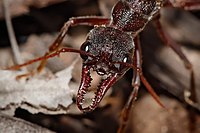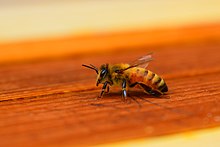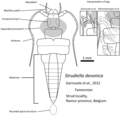Portal:Insects
The Insects Portal


Insects (from Latin insectum) are hexapod invertebrates of the class Insecta. They are the largest group within the arthropod phylum. Insects have a chitinous exoskeleton, a three-part body (head, thorax and abdomen), three pairs of jointed legs, compound eyes, and a pair of antennae. Insects are the most diverse group of animals, with more than a million described species; they represent more than half of all animal species. (Full article...)
Selected article -
A honey bee (also spelled honeybee) is a eusocial flying insect within the genus Apis of the bee clade, all native to mainland Afro-Eurasia. After bees spread naturally throughout Africa and Eurasia, humans became responsible for the current cosmopolitan distribution of honey bees, introducing multiple subspecies into South America (early 16th century), North America (early 17th century), and Australia (early 19th century).
Honey bees are known for their construction of perennial colonial nests from wax, the large size of their colonies, and surplus production and storage of honey, distinguishing their hives as a prized foraging target of many animals, including honey badgers, bears and human hunter-gatherers. Only 8 surviving species of honey bee are recognized, with a total of 43 subspecies, though historically 7 to 11 species are recognized. Honey bees represent only a small fraction of the roughly 20,000 known species of bees. (Full article...)Did you know -
- ... that Euprenolepis procera is the first ant discovered that harvests and feeds on mushrooms?
- .. that Milton Levine founded Uncle Milton's Toys, best known for its ant farm, with ants from the species Pogonomyrmex californicus?
- ... that Acromis spinifex is one of the few tortoise beetles that shows maternal care of its young?
- ... that the population density of Moroccan locust nymphs can reach several thousand individuals per square metre (11 sq ft)?
- ... that picnic beetles are attracted to beer?
List articles
Related portals
General images -
Selected image -

Abantiades latipennis (Lepidoptera: Hepialidae) is one of fourteen species in the Australian genus Abantiades. It thrives in regrowth forests that were previously clearfelled; the phytophagous larvae of A. latipennis feed primarily on the root systems of two species of tree, Eucalyptus obliqua (messmate stringybark) and Eucalyptus regnans (mountain ash).
WikiProjects

Main WikiProject:
Related projects:
- WikiProject Arthropods
- WikiProject Spiders
- WikiProject Animals
- WikiProject Tree of Life
- WikiProject Biology
Daughter projects:
Tasks
 |
Here are some tasks awaiting attention:
|
Associated Wikimedia
The following Wikimedia Foundation sister projects provide more on this subject:
-
Commons
Free media repository -
Wikibooks
Free textbooks and manuals -
Wikidata
Free knowledge base -
Wikinews
Free-content news -
Wikiquote
Collection of quotations -
Wikisource
Free-content library -
Wikiversity
Free learning tools -
Wiktionary
Dictionary and thesaurus




















































